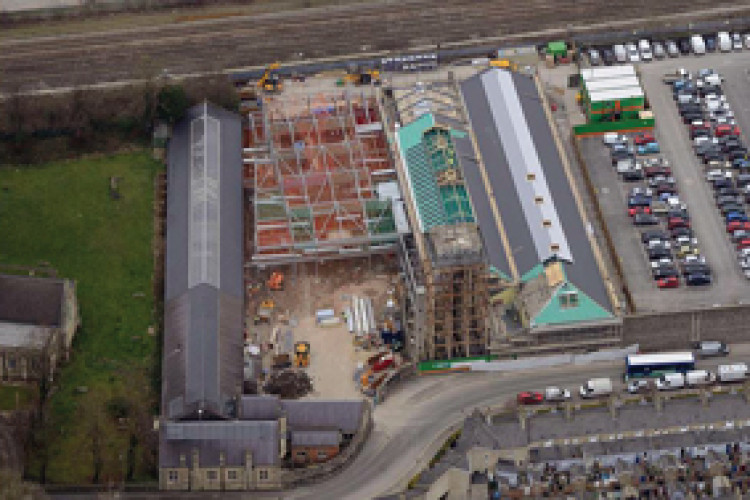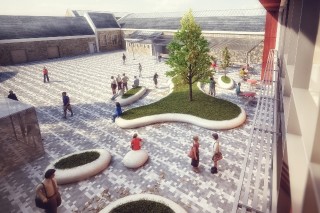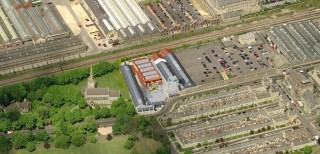Redeveloping an old industrial site is seldom straightforward, but at least in most cases you can knock down the old buildings and start again with a clean slate. Things get a bit more complicated when those old buildings are considered part of the locality’s ‘industrial heritage’ and are listed or located within a conservation area.
In Swindon there is no shortage of old industrial buildings, most of them standing as a reminder of the Wiltshire town’s role as a centre of the railway industry during the 19th and early 20th Centuries.
Located exactly midway between the major centres of Reading and Bristol, Swindon was the ideal place for Isambard Kingdom Brunel to establish the repair and maintenance headquarters for the Great Western Railway.
Within a few years train sheds, marshalling yards, foundries and workshops had sprung up in and around the town.
Much of the original infrastructure has long since disappeared, but one historic site, sandwiched between the main London – Bristol line and the row of pretty stone cottages built to house the GWR workers, still stands. The Old Sawmill, as it’s known, dates back to the mid-late 19th Century and was originally attached to the GWR carriage works. Now BAM Construction is giving the old buildings a new lease of life as the home of the new Swindon University Technical College (UTC).
When it’s completed later this year, Swindon UTC will provide students from ages 14 to 19 with courses combining the National Curriculum with specific technical and vocational subjects. It is the latest in a new breed of secondary school designed to teach the latest technologies under the leadership of a sponsoring university.
The Old Sawmill was originally part of the GWR Carriage & Wagon Works, most of which is now either demolished or gutted and redeveloped for light industrial use. But what remains is the most interesting part and while not all the buildings on the site are listed, a key element of the UTC design philosophy is to ‘preserve and enhance’ the railway village conservation area.
So-called ‘transparent’ building styles are being incorporated so that students and teachers can understand and appreciate how the buildings were engineered and constructed.
For BAM’s project manager Craig Madders, the challenge is not so much the size of the task but its complexity. “It’s a very fiddly site – every building is built a different way” he says.
The buildings, which occupy the western end of the original Carriage & Wagon Works site, comprise two large interconnecting brickbuilt sheds, oriented north-south. These were originally part of the sawmill where raw logs were delivered by train for the carriage works. “My theory is that when it was first built, it was designed so that you got logs delivered at one end of the site and finished railway carriages coming out the other” says Madders.
His theory seems sound – contemporary maps clearly show the sawmill to the west with the body shop, repair shop, paint shop, trimmers, finishers and polishers, as well as a couple of storehouses, ranged along to the east.
These are all now gone. The two buildings that comprise the sawmill are known at the Canopy and the Old Mill – names which the construction team has given them to distinguish one from the other. These buildings were constructed partially on made ground, supported by a Grade II listed stone retaining wall to the south, along Bristol Street. This compensated for the natural fall of the land, bringing it up level with the railway line to the north.
However, whereas the Canopy building is a single-storey structure built on top of this fill material, the Old Mill building adjacent to it is built into it making it a two-storey structure with a ground floor at street level.
The Canopy building is so-called because when BAM took possession of the site, it essentially had no external walls. Instead the slate and glass clerestory roof is supported on cast iron columns (made in Wolverhampton in 1878, the date and place of manufacture cast into them) and acting like a canopy.
BAM is now constructing an entirely new building within this envelope. And while the new structure is in keeping with the existing components, it is structurally independent. “We can’t let the walls impose any wind loading on the columns or the roof, so what we’ve done is support the wall with raking steelwork hidden inside the internal walls and transferring the side-loadings down onto the floor” explains Madders.
The floor itself is also new, a concrete beamand- block construction raised approximately 600mm above the original concrete floor. This is one of the fiddly details resulting from having to accommodate the original building design. Because the Canopy building and the Old Mill are contiguous, the architect wanted everything on the same level, and although the floors were indeed level, the subbasement in the Old Mill was low and pokey; the ceiling had to be raised.
In the Canopy, BAM has piled down through the made ground underneath the floor slab and built its new concrete floor on beams resting on the pile caps.
Next door, in the Old Mill, a completely different solution was needed. The existing iron columns have been retained and spacers in the shape of new steel trusses are now fixed on top of them to support the new composite steel and concrete floor.

“Arup had to do a lot of testing and calculation to ensure that the old columns were strong enough to support the trusses and the composite floor” says Madders. “But actually, it’s quite a light structure and they’re more than capable.”
The iron columns are not the only original features being restored in these buildings. The roof structures are also being refurbished and will remain exposed. Much of the original tongue-and-grooved softwood sarking, although peeling and tatty, is actually in reasonable condition and is being simply stripped and repainted.
The roofs themselves, however, are being completely rebuilt with new artificial slates and the original clerestory glass replaced with lightweight polycarbonate. The new roof structure is of course insulated to meet Part L of the Building Regulations. Indeed the Canopy and Old Mill are being built to BREEAM "very good" standard.
Calculating the admissible roof loadings was complicated by the variety of roof trusses in the two buildings – there are at least three different designs, incorporating cast iron and steel components.
An extension to the north of the Old Mill is built on the same level as the neighbouring Canopy building. But BAM’s intention to use the same beam-and-block solution for the floor here was thwarted by underground obstructions.
“We found ourselves trying to pile through the remains of the old steam engine which had powered the sawmill” says Madders. “We only managed to get two piles in”. BAM found a solution in the form of steel I-beams inserted through the walls and supported mid-span by a secondary beam resting on the two pilecaps. This will have a suspended timber floor when completed. To the west of the Old Mill building is the central courtyard, around which are ranged the most interesting historical parts of the building: the old school, fire station and water tower, all of which are Grade II listed. The water tower is a delicate lattice of wrought iron and cast iron and is about 20m tall. The only part that is not original is the actual water tank sitting on top. Rising up alongside is a bizarre-looking timber-clad shed, very tall and very narrow.
“That is the drying shed for the fire-hoses” explains Madders. “The old hoses were made of canvas. If you put them away wet they’d just rot. So after they had been used, they were hung up inside the shed to dry. These structures, in remarkable condition for their age, are being painstakingly restored and will be re-painted in the original GWR colours of green and cream.
“We will grit-blast all the old paint off the water tower, but we’ll have to completely encapsulate it and install an onsite decontamination unit because it’s all old lead-based paint” says Madders.
Opposite the water tower is an 80m-long, 12m-wide stone building which housed the fire station itself. At the southern extremity is the old school, built to educate the children of the GWR workers who lived in the terraced cottages on the other side of the road. This long, narrow building once also housed the GWR laboratories which carried out materials testing and analysis for the whole site. Much of the original Victorian furniture, including sinks, taps and benches, remains in good condition and will be re-used elsewhere in the UTC building.
The old school will house the new staff-room, principal’s office and administrative suite while the 80m-long fire station will be restored to its original layout to form one enormous engineering workshop.
After the fire station was decommissioned in the 1980s, the long building was subdivided and rented out as light industrial units. Many of these were still occupied until relatively recently. “The last tenant only moved out just before Christmas” says Madders.
One of these tenants was ESG – specialist in testing, inspection and compliance which BAM employed to carry out asbestos analysis on the site.
In the northern half of the courtyard is the only new-build element of the UTC project, the Learning Resource Centre (LRC). Although physically linked to the Old Mill along its eastern perimeter, a narrow gap is deliberately left to allow daylight through, to emphasise the integrity of the heritage building. The entire ground floor of the LRC building is also to be clad with a glass curtain wall system to allow natural light in and avoid the new-build dominating the existing architecture. Given the complicated nature of the project, the contract timescale is remarkably fast-track: “We arrived on-site in October 2013 and the first kids arrive at the college on 15th September 2014” says Madders. “We’ve got less than a year”.
Were it not for the fact that the site is hemmed-in on every side, this might not be such a challenge for the contractor. However, with the various different levels and very limited space around the site, manoeuvring plant and materials has been a bit of a headache.
There are just two access points, both height-restricted. One measures 5.6m wide but has only 2.4m of headroom; the other is 4.5m high but is less than 4m wide. “There’s no way we can get an artic truck in” says Madders. There is also no tower crane on site, although mobile cranes have been used to deliver bulky materials and a self-erecting tower crane was also used during the early weeks. Plant and materials that need transporting from one end of the relatively small site have to leave by one entrance and negotiate Swindon’s narrow one-way system to arrive at the other.
This lack of mechanical handling capability meant that the Canopy’s 1,000m2 concrete beam and block floor took half a dozen workers two weeks to assemble using a variety of manual hoists and trolleys to manoeuvre the components, weighing up to 250kg each. Now just over half-way through, the project is beginning to take shape and Madders is confident that BAM will meet its September deadline, despite the complexity of the task. “This is probably the most complicated project I’ve worked on, but it’s still cheaper than new-build because a lot of the structure’s already there,” he says. “But in many ways it’s more challenging because you have to work with what you’ve got and you’re always looking for the smartest solution. This sort of project is for thinkers!”
This article first appeared in the May 2014 issue of The Construction Index magazine, which can be viewed in full at: http://epublishing.theconstructionindex.co.uk/magazine/may2014
While the magazine is free to view online, a subscription is required to receive you own hard copy every month. This can be purchased for just £35 a year at http://www.theconstructionindex.co.uk/magazine
Got a story? Email news@theconstructionindex.co.uk





